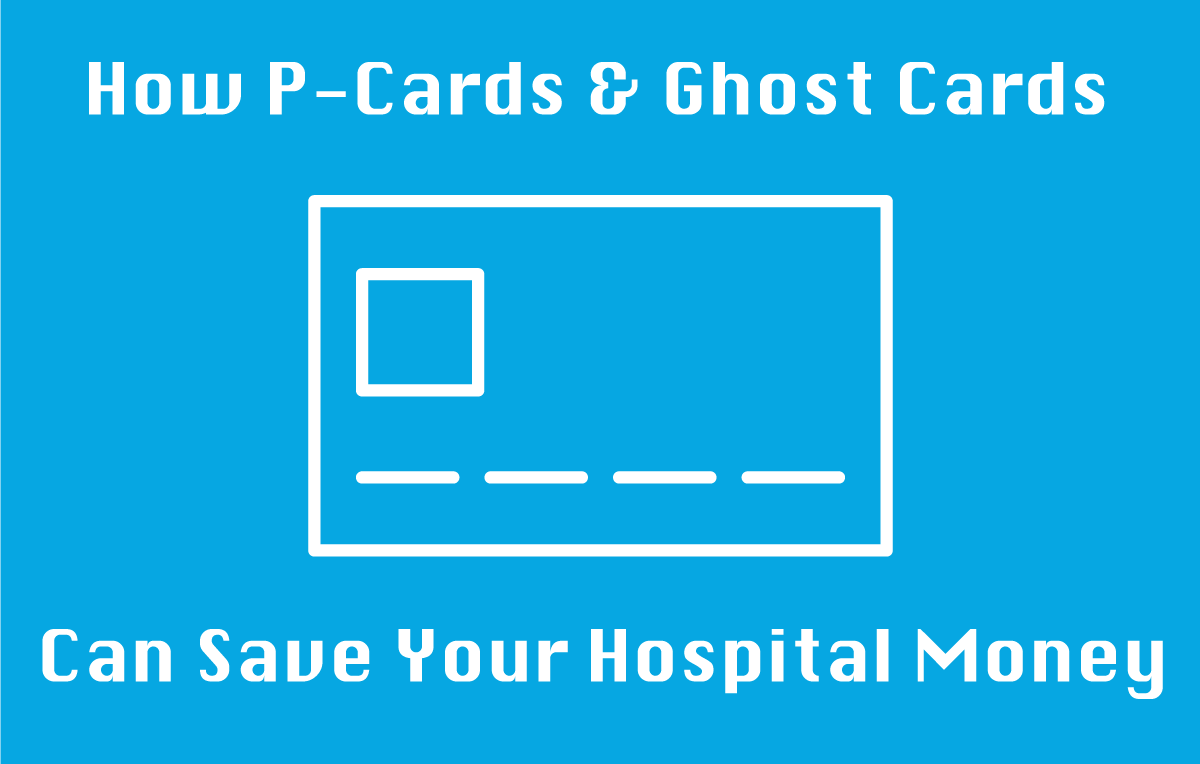Procurement cards, also known as purchasing cards or P-cards, and virtual ghost cards are excellent tools used by hospitals to simplify and streamline the purchasing process. Organizations that use them can enjoy significant savings if they are controlled and managed properly.

What are P-Cards & Ghost Cards?
A P-card is essentially a business-to-business credit card. It operates on the same Visa or MasterCard networks as consumer credit cards, and it’s typically issued to department managers or buyers for purchases. They are similar to the travel credit cards that some companies issue to personnel to cover travel expenses.
A virtual ghost card, on the other hand, is a credit card number thats specific to each company department and can be used by anyone in that department. Purchases made on ghost cards are charged back to the department under which the card was issued. This not only makes it easier to assign purchases to departments, but allows more employees access to this purchasing option. Ghost cards can also be issued to select suppliers who then charge the card number for every purchase a specific hospital department makes. These cards are used for purchasing both medical supplies and mainly low-end equipment. Roughly 10 to 15 percent of invoiced spend goes through hospital ghost cards.
Both P-cards and ghost cards have additional features not found with regular credit cards. Namely, there are controls that the hospital can put in place to prevent its misuse, such as enforcing monthly limits, single-purchase limits, cash advance restrictions, and vendor category codes that limit transactions to specific types of vendors. These controls can be set for all cards the hospital uses, on a per-department basis, or even for individual users.
Both types of cards are useful in situations where a vendor takes only cash and credit cards, or hasnt established an account with the hospital to go through the traditional purchase order process.
Advantages of P-Cards & Ghost Cards
The benefits of using P-cards and ghost cards are significant:
- The user does not have to make purchases out-of-pocket and then submit a reimbursement request and wait for it to be approved and paid; the payment is made directly from the hospitals bank account every month.
- There is no need to go through the hassle of a petty cash request and approval process.
- The controls available can prevent abuse and are customizable by the hospital.
- The hospitals procurement organization doesnt have to spend time going through a complete procurement cycle for every low-dollar purchase, and they are able to go online or even use mobile apps to see activity on each card any time. (Some P-card providers update purchase information in real time, and others do so periodically throughout the day.)
Although purchases with P-cards and ghost cards typically do not take advantage of pricing agreements between the hospital and vendors, many P-cards have a rebate feature that can offer similar, if not greater, savings.
Programs vary from one P-card or ghost card provider to another. Its a tiered system, and based on Visa or Mastercards interchange schedules and each clients transaction activity, rebates can be up to one percent of cardable spend or morea significant amount these days when hospitals are looking for savings in every nook and cranny. Industry insiders say that hospitals can realistically reach levels of close to 20% of total non-labor spend going on a P-card and/or ghost card. With $200 million in spend, thats $40 million in cardable spend and a potentially $400 thousand in rebates.
Disadvantages of P-Cards & Ghost Cards
For organizations that have never used P-cards or ghost cards, they may be viewed with some suspicion. The fact that payment comes directly out of the hospitals bank account without going through an oversight or approval process strikes fear in the hearts of more than a few CFOs. And indeed, both types of cards have to be properly managed and controlled:
- The organization should have written rules about who can obtain a card, what it can be used for, and what the monthly and per-purchase limits are.
- Users should be accountable for all purchases they make, supplying receipts or other evidence the same way they would do with travel expenses. There should also be a process for identifying and dealing with personal expenditures (perhaps the employee reimburses the hospital with a payroll deduction).
Another hurdle can come during the payment conversion process. During supplier enablement, vendors are electronically connected to the hospital supply chain. The vendor will then be able to exchange critical business documents such as invoices, purchase orders, etc. This is accomplished via Extensible Markup Language (XML), Electronic Data Interchange (EDI), RFID chips, web forms, or other processes.
The process of switching over payment from check to a purchasing or ghost card (ACH/EFT) can be challenging as every supplier must be contacted and informed of the change. Depending on the bank you choose, they may help you in making this transition easier and more efficient.
You may also get pushback from some of your vendors, as transaction acceptance fees may make them resist or even deny P-card and ghost card payments. Furthermore, some vendors will impose a surcharge in conjunction with accepting payment via card.
If you do encounter vendors that are resistant to transferring payment to P-cards and/or ghost cards, your hospital may need to educate them on the benefits of these cards using examples of other successful vendor relationships.
Conclusion
P-cards and ghost cards can save time and paperwork by consolidating low-dollar purchases into a single monthly payment, with full visibility on every transaction. With rebates on top of that, there is little reason not to explore the offerings from different card providers to find deals and features that are right for your organization.

